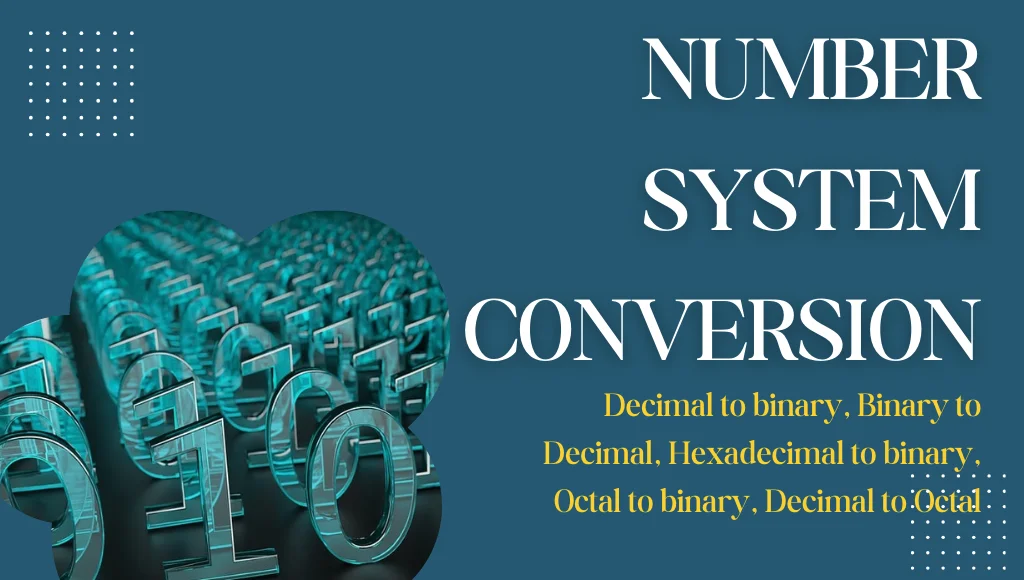
Number System Conversions: Binary, Decimal, Octal & Hexadecimal
Numbers form the foundation of computing, digital logic, and everyday mathematics. However, different number systems—Decimal, Binary, Octal, and Hexadecimal—are used in various applications. Understanding these systems is crucial for students, programmers, and engineers alike!
In this blog post, we will explore number system conversions in depth. You'll learn the step-by-step methods for converting between different bases, complete with examples. Plus, you can use our Number System Converter to automate the process effortlessly. Let’s dive in!
In this guide, we will explore conversions between the four most commonly used bases:
- Decimal (Base 10) – Used in everyday mathematics.
- Binary (Base 2) – The language of computers.
- Octal (Base 8) – Used in computing as a shorthand for binary.
- Hexadecimal (Base 16) – Common in memory addressing and digital circuits.
1. Decimal Conversions
Decimal to Binary
Divide the number by 2 repeatedly and record the remainders.
Example: Convert 2510 to binary
25 ÷ 2 = 12 remainder 1 ↑
12 ÷ 2 = 6 remainder 0 ↑
6 ÷ 2 = 3 remainder 0 ↑
3 ÷ 2 = 1 remainder 1 ↑
1 ÷ 2 = 0 remainder 1 ↑
Result: 110012
Decimal to Octal
Divide the number by 8 repeatedly.
Example: Convert 9510 to octal
95 ÷ 8 = 11 remainder 7 ↑
11 ÷ 8 = 1 remainder 3 ↑
1 ÷ 8 = 0 remainder 1 ↑
Result: 1378
Decimal to Hexadecimal
Divide the number by 16 and use letters A-F for values 10-15.
Example: Convert 25510 to hex
255 ÷ 16 = 15 remainder 15 (F) ↑
15 ÷ 16 = 0 remainder 15 (F) ↑
Result: FF16
2. Binary Conversions
Binary to Decimal
Multiply each binary digit by powers of 2.
Example: Convert 110012 to decimal
(1×2⁴) + (1×2³) + (0×2²) + (0×2¹) + (1×2⁰)
16 + 8 + 0 + 0 + 1 = 2510
Binary to Octal
Group bits into sets of three (from right).
Example: Convert 101101102 to octal
010 110 110 (add leading zero)
2 6 6 → 2668
Binary to Hexadecimal
Group bits into sets of four.
Example: Convert 101101102 to hex
1011 0110
B 6 → B616
3. Octal Conversions
Octal to Decimal
Multiply each octal digit by powers of 8.
Example: Convert 1378 to decimal
(1×8²) + (3×8¹) + (7×8⁰)
64 + 24 + 7 = 9510
Octal to Binary
Convert each digit to a 3-bit binary value.
Example: Convert 2668 to binary
2 → 010
6 → 110
6 → 110
Result: 0101101102 (remove leading zero → 10110110)
4. Hexadecimal Conversions
Hexadecimal to Decimal
Multiply each hexadecimal digit by powers of 16.
Example: Convert B616 to decimal
(11×16¹) + (6×16⁰)
176 + 6 = 18210
Hexadecimal to Binary
Convert each digit to a 4-bit binary value.
Example: Convert B616 to binary
B → 1011
6 → 0110
Result: 101101102
5. Octal ↔ Hexadecimal Conversion
Convert via binary as an intermediate step.
Example: Convert 1578 to hex
1. Convert 1578 to binary → 001 101 1112
2. Group into four-bit sets: 0110 11112
3. Convert to hex: 0110 = 6, 1111 = F
Result: 6F16
Conclusion
This blog post explores number system conversions, covering Decimal, Binary, Octal, and Hexadecimal. It explains step-by-step methods for conversions, including Decimal to Binary, Binary to Decimal, Decimal to Octal, Octal to Decimal, Decimal to Hexadecimal, and Hexadecimal to Decimal, with clear examples. Additionally, it provides quick methods for Binary to Octal and Binary to Hexadecimal conversions. Whether you're a student, programmer, or engineer, mastering these conversions is essential. Plus, try our interactive Number System Converter to simplify the process!

